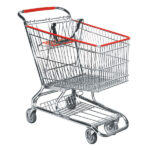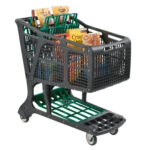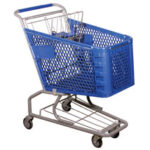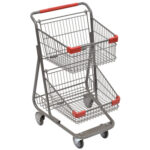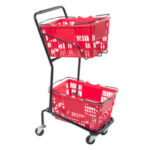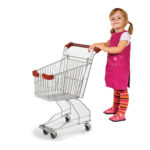When it comes to retail environments, the shopping cart significantly influences the shopping experience. From metal and plastic to large bin and small bin, each type of shopping cart offers distinct benefits and downsides. This comprehensive guide explores the various types of shopping carts available, their advantages, and their potential drawbacks to help you make an informed decision for your retail store.
Metal Shopping Carts
Metal shopping carts stand out for their robustness and long-lasting nature. They withstand heavy usage and resist breaking or warping under pressure. The weight of metal carts enhances stability, reducing the risk of tipping over. This feature is essential for customer safety. Additionally, metal carts are highly recyclable, appealing to environmentally conscious customers and businesses.
However, the heaviness of metal carts can challenge some customers, especially the elderly or those with physical limitations. Metal carts also tend to be more expensive upfront compared to plastic or other alternatives. They require proper maintenance to avoid rust, especially in humid environments. A study by the Retail Industry Leaders Association (RILA) indicates that metal carts can increase customer satisfaction by up to 25% due to their durability and stability (Real Simple) (Carriage Trade Service Co., Inc).
Plastic Shopping Carts
Plastic shopping carts offer several benefits, primarily due to their lightweight nature. This feature makes them easier to maneuver, enhancing the shopping experience for all customers. These carts come in various colors, allowing for customization to match store branding. An added advantage is that plastic carts do not rust. This reduces maintenance costs and extends their lifespan in certain environments.
However, plastic carts generally lack the durability of their metal counterparts and can crack or break under heavy use. While some plastic carts use recycled materials, they are less recyclable at the end of their life cycle compared to metal. Additionally, their lightweight nature can compromise stability, posing a higher risk of tipping over. Research from the National Retail Federation (NRF) shows that stores using a mix of plastic and metal carts tend to see higher average purchase values. Customers appreciate having options based on their needs (Web-Hobbies) (WordStream).
Large Bin Carts
Large bin carts excel due to their ample space, making them ideal for customers with long shopping lists or those purchasing bulk items. They reduce the need for multiple trips to the store, enhancing customer convenience. These large bin carts accommodate a wide variety of products, from groceries to large household items.
However, large bin carts can be cumbersome in smaller retail environments or narrow aisles. When fully loaded, these carts can become very heavy and difficult to maneuver. Moreover, larger carts typically come with a higher price tag. This may concern budget-conscious retailers. An industry trend towards bulk shopping and warehouse-style stores has increased the popularity of large bin carts. They align well with customer purchasing behaviors (Carriage Trade Service Co., Inc) (PYMNTS.com).
Small Bin Carts
Small bin carts offer excellent maneuverability, making them easier to navigate through crowded aisles and tight spaces. Their smaller footprint suits smaller stores or stores with limited space. They are generally less expensive than larger carts, making them a cost-effective option. However, the smaller size means less storage space. This can inconvenience customers with larger shopping needs.
Customers may need to make more frequent trips to the store if using a small bin cart. Additionally, some customers might perceive smaller carts as less accommodating, impacting their overall shopping experience. According to RILA, small bin carts are particularly favored in urban retail settings where space is at a premium (Carriage Trade Service Co., Inc) (Shekel scales).
Basket Carts
Basket carts, known for their portability and lightweight nature, suit quick trips and small purchases. They take up minimal space, both in the store and when stored at home. Basket carts usually cost less than full-sized carts. However, basket carts are only suitable for small shopping trips and cannot handle larger items. They generally lack the durability of larger carts and may need replacement more frequently.
Carrying a basket for extended periods can also be uncomfortable, especially if it becomes heavy. Retailers note that basket carts expedite the shopping process, reducing the time customers spend in the store and increasing overall store efficiency (Real Simple) (Shekel scales).
Kids’ Carts
Kids’ carts engage children, making the shopping experience more enjoyable for families. They serve as tools to teach children about shopping and responsibility. Providing kids’ carts can enhance overall customer satisfaction, encouraging repeat business. However, kids’ carts take up additional storage space when not in use and pose a potential risk of accidents if children are not supervised properly while using them.
They may also require more frequent maintenance and cleaning due to rough handling by children. Retailers who offer kids’ carts often find that they can extend the time families spend in the store, which often translates to higher sales. This trend is supported by NRF research, which indicates that engaging children during shopping trips can lead to increased customer loyalty and higher average transaction values (Carriage Trade Service Co., Inc) (Shekel scales).
Smart Shopping Carts
Smart shopping carts revolutionize the retail experience by integrating advanced technologies such as mobile connectivity, artificial intelligence (AI), and machine learning. These carts collect real-time data on customer purchases, helping retailers track inventory levels and make informed decisions about restocking. Additionally, smart carts offer personalized product recommendations and discounts based on customer data, enhancing the shopping experience and boosting sales.
For example, the Caper Cart uses computer vision and AI to remind customers of items they might have forgotten, leading to larger average basket sizes. Moreover, smart carts enable cashierless checkout, reducing wait times and improving convenience for customers (PYMNTS.com) (FLOW) (WordStream). This feature makes smart shopping carts from brands like Amazon and Walmart popular choices for modern retailers.
Smart carts also empower retailers to optimize store layouts by collecting data on customer movement and item popularity. This allows for more efficient product placement and aisle management. This technology can also repurpose employees to focus on customer service rather than checkout duties, further enhancing the shopping experience (Shekel scales) (PYMNTS.com).
Conclusion
Selecting the right type of shopping cart for your retail store involves balancing various factors, including durability, cost, customer convenience, and space availability. Metal carts offer durability and stability but come at a higher cost and weight. Plastic carts provide a lightweight and rust-free option but may lack the durability of metal. Large bin carts cater to bulk shoppers but require more space and are harder to maneuver when full.
Small bin carts offer excellent maneuverability and cost savings but have limited capacity. Basket carts are perfect for quick trips and small purchases but are less comfortable for extended use. Finally, kids’ carts add an element of fun and engagement for young shoppers but require careful supervision and additional storage.
By understanding the benefits and downsides of each type, you can make an informed decision that enhances your customers’ shopping experience and aligns with your store’s operational needs. Investing in the right mix of shopping carts can significantly impact customer satisfaction, encourage longer shopping trips, and ultimately increase sales. Each type of cart serves a unique purpose and caters to different customer needs, so consider your target demographic and store layout when making your selection.
Whether you prioritize durability, ease of use, or customer engagement, the right shopping cart can make all the difference in creating a pleasant and efficient shopping environment. As industry trends evolve, staying informed about customer preferences and emerging technologies in shopping cart design will ensure your store remains competitive and meets the ever-changing demands of the retail landscape (Real Simple) (Web-Hobbies) (WordStream) (WordStream).


